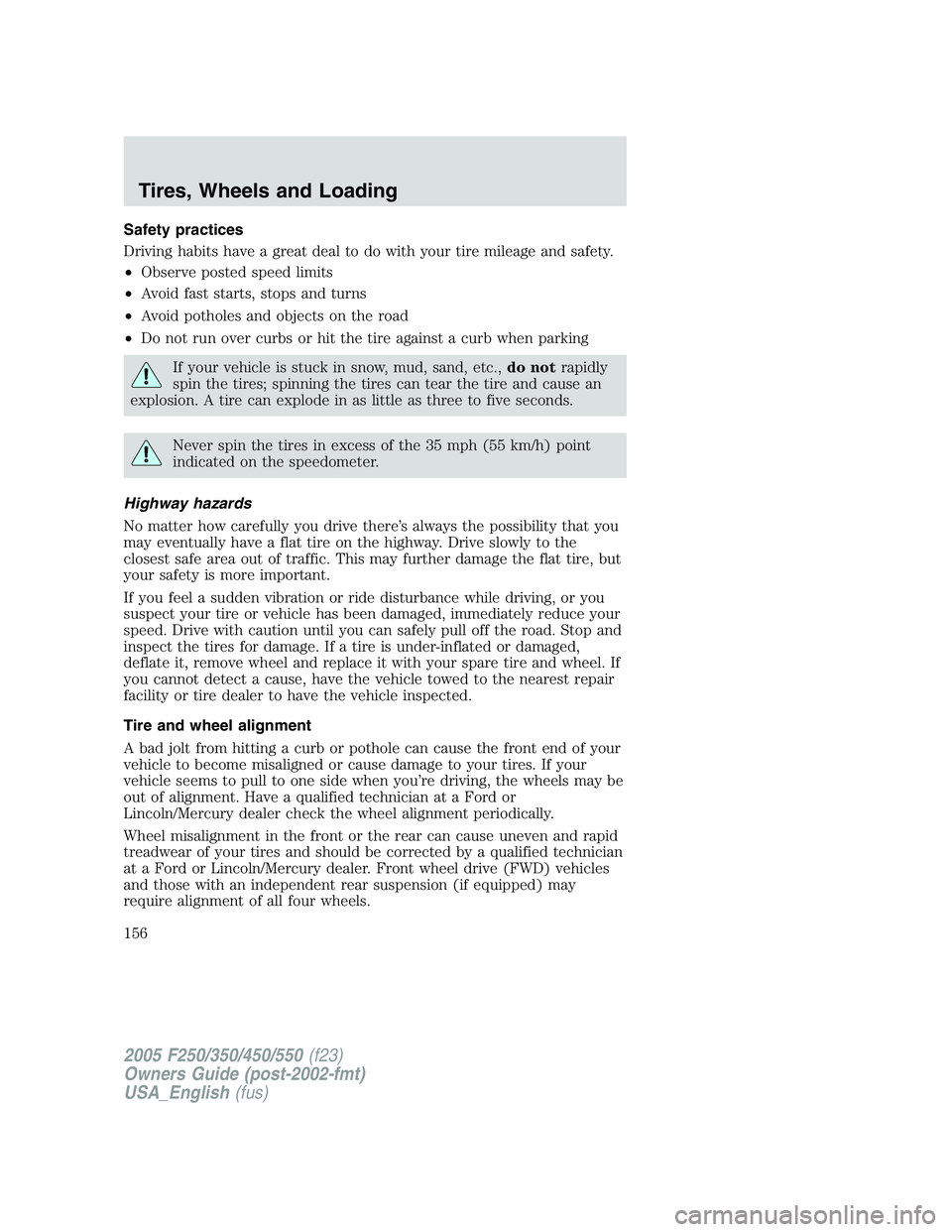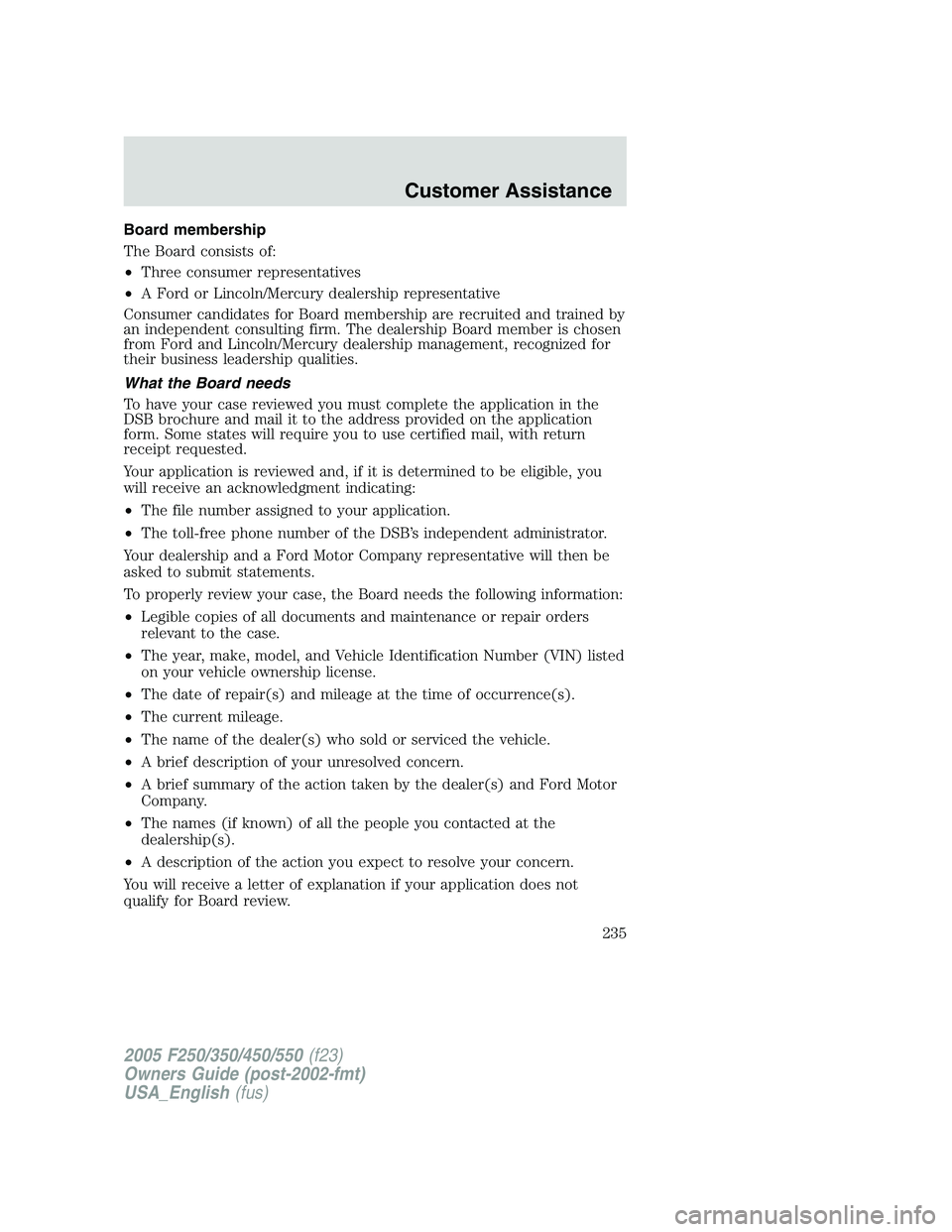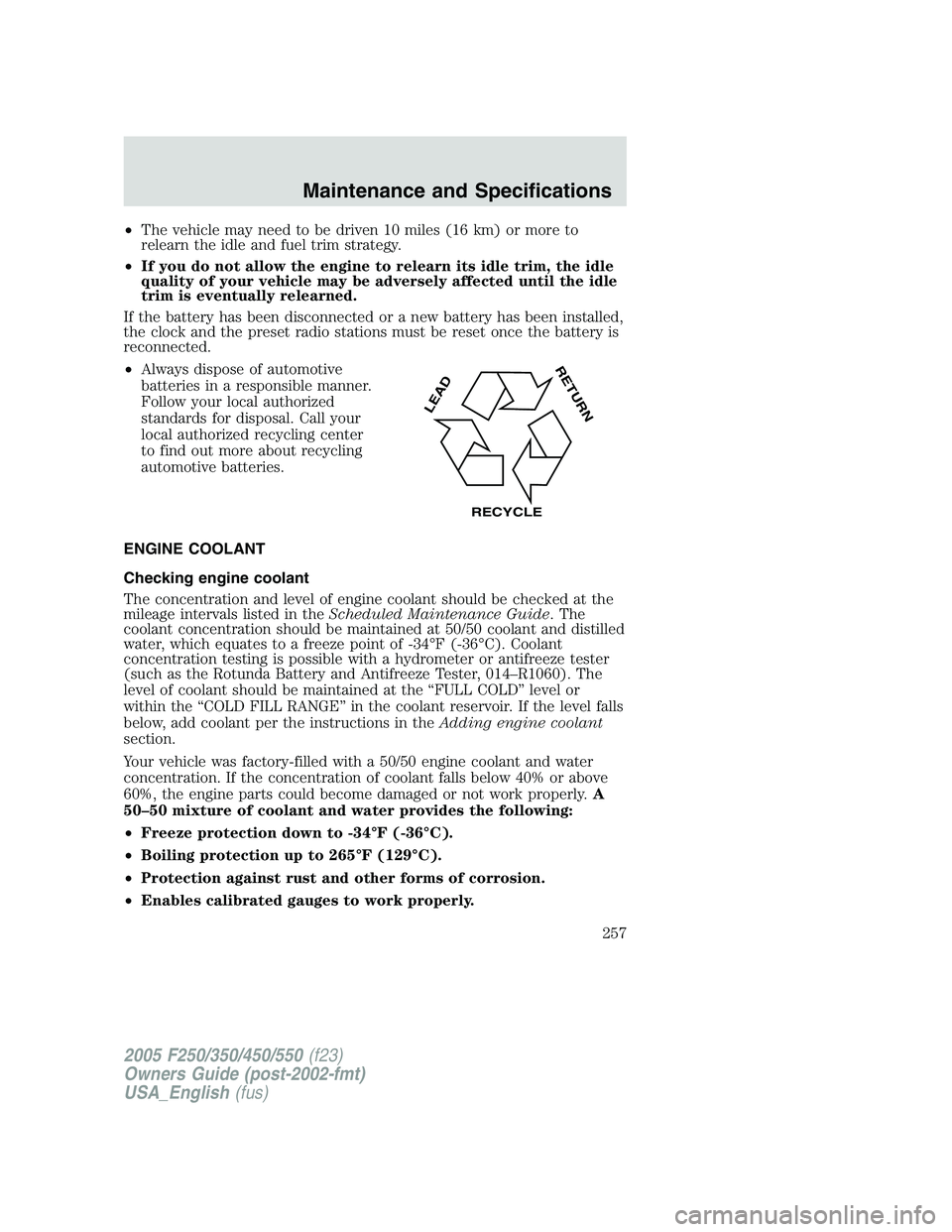mileage FORD F250 SUPER DUTY 2005 Owners Manual
[x] Cancel search | Manufacturer: FORD, Model Year: 2005, Model line: F250 SUPER DUTY, Model: FORD F250 SUPER DUTY 2005Pages: 312, PDF Size: 4.8 MB
Page 156 of 312

Safety practices
Driving habits have a great deal to do with your tire mileage and safety.
• Observe posted speed limits
• Avoid fast starts, stops and turns
• Avoid potholes and objects on the road
• Do not run over curbs or hit the tire against a curb when parking
If your vehicle is stuck in snow, mud, sand, etc., do not rapidly
spin the tires; spinning the tires can tear the tire and cause an
explosion. A tire can explode in as little as three to five seconds.
Never spin the tires in excess of the 35 mph (55 km/h) point
indicated on the speedometer.
Highway hazards
No matter how carefully you drive there’s always the possibility that you
may eventually have a flat tire on the highway. Drive slowly to the
closest safe area out of traffic. This may further damage the flat tire, but
your safety is more important.
If you feel a sudden vibration or ride disturbance while driving, or you
suspect your tire or vehicle has been damaged, immediately reduce your
speed. Drive with caution until you can safely pull off the road. Stop and
inspect the tires for damage. If a tire is under-inflated or damaged,
deflate it, remove wheel and replace it with your spare tire and wheel. If
you cannot detect a cause, have the vehicle towed to the nearest repair
facility or tire dealer to have the vehicle inspected.
Tire and wheel alignment
A bad jolt from hitting a curb or pothole can cause the front end of your
vehicle to become misaligned or cause damage to your tires. If your
vehicle seems to pull to one side when you’re driving, the wheels may be
out of alignment. Have a qualified technician at a Ford or
Lincoln/Mercury dealer check the wheel alignment periodically.
Wheel misalignment in the front or the rear can cause uneven and rapid
treadwear of your tires and should be corrected by a qualified technician
at a Ford or Lincoln/Mercury dealer. Front wheel drive (FWD) vehicles
and those with an independent rear suspension (if equipped) may
require alignment of all four wheels.
2005 F250/350/450/550 (f23)
Owners Guide (post-2002-fmt)
USA_English (fus)Tires, Wheels and Loading
156
Page 235 of 312

Board membership
The Board consists of:
• Three consumer representatives
• A Ford or Lincoln/Mercury dealership representative
Consumer candidates for Board membership are recruited and trained by
an independent consulting firm. The dealership Board member is chosen
from Ford and Lincoln/Mercury dealership management, recognized for
their business leadership qualities.
What the Board needs
To have your case reviewed you must complete the application in the
DSB brochure and mail it to the address provided on the application
form. Some states will require you to use certified mail, with return
receipt requested.
Your application is reviewed and, if it is determined to be eligible, you
will receive an acknowledgment indicating:
• The file number assigned to your application.
• The toll-free phone number of the DSB’s independent administrator.
Your dealership and a Ford Motor Company representative will then be
asked to submit statements.
To properly review your case, the Board needs the following information:
• Legible copies of all documents and maintenance or repair orders
relevant to the case.
• The year, make, model, and Vehicle Identification Number (VIN) listed
on your vehicle ownership license.
• The date of repair(s) and mileage at the time of occurrence(s).
• The current mileage.
• The name of the dealer(s) who sold or serviced the vehicle.
• A brief description of your unresolved concern.
• A brief summary of the action taken by the dealer(s) and Ford Motor
Company.
• The names (if known) of all the people you contacted at the
dealership(s).
• A description of the action you expect to resolve your concern.
You will receive a letter of explanation if your application does not
qualify for Board review.
2005 F250/350/450/550 (f23)
Owners Guide (post-2002-fmt)
USA_English (fus) Customer Assistance
235
Page 257 of 312

• The vehicle may need to be driven 10 miles (16 km) or more to
relearn the idle and fuel trim strategy.
• If you do not allow the engine to relearn its idle trim, the idle
quality of your vehicle may be adversely affected until the idle
trim is eventually relearned.
If the battery has been disconnected or a new battery has been installed,
the clock and the preset radio stations must be reset once the battery is
reconnected.
• Always dispose of automotive
batteries in a responsible manner.
Follow your local authorized
standards for disposal. Call your
local authorized recycling center
to find out more about recycling
automotive batteries.
ENGINE COOLANT
Checking engine coolant
The concentration and level of engine coolant should be checked at the
mileage intervals listed in the Scheduled Maintenance Guide . The
coolant concentration should be maintained at 50/50 coolant and distilled
water, which equates to a freeze point of -34°F (-36°C). Coolant
concentration testing is possible with a hydrometer or antifreeze tester
(such as the Rotunda Battery and Antifreeze Tester, 014–R1060). The
level of coolant should be maintained at the “FULL COLD” level or
within the “COLD FILL RANGE” in the coolant reservoir. If the level falls
below, add coolant per the instructions in the Adding engine coolant
section.
Your vehicle was factory-filled with a 50/50 engine coolant and water
concentration. If the concentration of coolant falls below 40% or above
60%, the engine parts could become damaged or not work properly. A
50–50 mixture of coolant and water provides the following:
• Freeze protection down to -34°F (-36°C).
• Boiling protection up to 265°F (129°C).
• Protection against rust and other forms of corrosion.
• Enables calibrated gauges to work properly.
L E A D
RETURN
RECYCLE
2005 F250/350/450/550 (f23)
Owners Guide (post-2002-fmt)
USA_English (fus) Maintenance and Specifications
257
Page 304 of 312

dipstick ....................................251
filter, specifications ........254, 282
recommendations ...................254
refill capacities ........................283
specifications ..................286, 289
Exhaust fumes ..........................183
F
Fail safe coolant ........................262
Fluid capacities .........................283
Foglamps .....................................40
Four-Wheel Drive vehicles .......195
description ..............................200
driving off road .......................202
electronic shift ................196, 200
indicator light .........................197
lever operated shift ................197
manual locking hubs ..............196
preparing to drive your
vehicle .....................................186
Fuel ............................................263
calculating fuel
economy ............................71, 267
cap ...........................................265
capacity ...................................283
choosing the right fuel ...........266
comparisons with EPA fuel
economy estimates .................270
detergent in fuel .....................267
filling your vehicle with
fuel ...........................263, 265, 268
filter, specifications ........267, 282
fuel pump shut-off switch .....214
improving fuel economy ........267
octane rating ...................266, 289
quality ......................................266
running out of fuel .................267 safety information relating to
automotive fuels .....................263
Fuel pump shut-off switch .......214
Fuses ..................................215–216
G
Gas cap (see Fuel cap) ............265
Gas mileage
(see Fuel economy) .................267
Gauges .........................................16
transmission fluid
temperature gauge ...................20
H
Hazard flashers .........................214
Head restraints ...........................89
Headlamps ...................................39
aiming ..................................41, 43
autolamp system .......................39
daytime running lights .............40
flash to pass ..............................41
high beam .................................41
replacing bulbs .............46, 48–49
turning on and off ....................39
Heating
heating and air conditioning
system ...........................33–34, 36
Hood ..........................................248
I
Ignition ...............................178, 289
Infant seats
(see Safety seats) .....................119
Inspection/maintenance (I/M)
testing ........................................272
2005 F250/350/450/550 (f23)
Owners Guide (post-2002-fmt)
USA_English (fus)Index
304